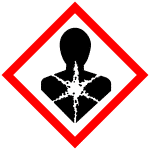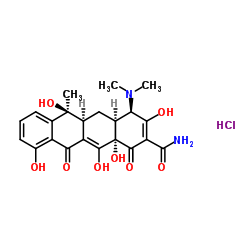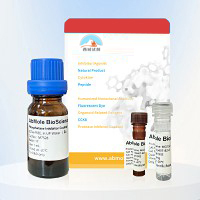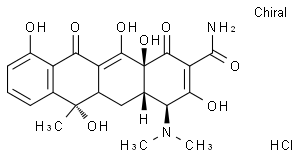Epitetracycline hydrochloride, 99%,Epitetracycline hydrochloride
产品编号:西域试剂-WR145988| CAS NO:23313-80-6| 分子式:C22H24N2O8 • HCl| 分子量:480.9
4-表四环素盐酸盐是抗生素四环素的差向异构体。四环素的差向异构体没有催化作用,被认为是降解产物。4-上皮性四环素盐酸盐作为抗生素或Tet抑制效应剂的活性降低,但对动物可能有更强的毒性作用。
本网站销售的所有产品仅用于工业应用或者科学研究等非医疗目的,不可用于人类或动物的临床诊断或者治疗,非药用,非食用,
| 英文名称 | Epitetracycline hydrochloride |
|---|---|
| CAS编号 | 23313-80-6 |
| 产品描述 | 4-表四环素盐酸盐是抗生素四环素的差向异构体。四环素的差向异构体没有催化作用,被认为是降解产物。4-上皮性四环素盐酸盐作为抗生素或Tet抑制效应剂的活性降低,但对动物可能有更强的毒性作用。 |
| 产品熔点 | 217ºC |
| 产品沸点 | 682.8ºC at 760mmHg |
| 产品闪点 | 366.7ºC |
| 精确质量 | 480.129944 |
| PSA | 181.62000 |
| LogP | 1.28790 |
| 外观性状 | Fine Crystalline Powder | Yellow |
| 折射率 | 1.74 |
| 稳定性 | 遵照规定使用和储存则不会分解。 |
| 储存条件 | 密闭于阴凉干燥环境中 |
相关文档
化学品安全说明书(MSDS)
下载MSDS质检证书(COA)
相关产品
| 符号 |


GHS07, GHS08 |
|---|---|
| 信号词 | Warning |
| 危害声明 | H315-H319-H335-H361 |
| 警示性声明 | P280-P305 + P351 + P338 |
| 个人防护装备 | Eyeshields;full-face particle respirator type N100 (US);Gloves;respirator cartridge type N100 (US);type P1 (EN143) respirator filter;type P3 (EN 143) respirator cartridges |
| 危害码 (欧洲) | Xn: Harmful; |
| 风险声明 (欧洲) | 63-36-36/37/38 |
| 安全声明 (欧洲) | 36/37/39-26-36 |
| 危险品运输编码 | NONH for all modes of transport |
| RTECS号 | QJ1898250 |
| 海关编码 | 29413000 |
Synonym:Quatrimycin Hydrochloride Section 2 - COMPOSITION, INFORMATION ON INGREDIENTS
Risk Phrases: 63 Section 3 - HAZARDS IDENTIFICATION EMERGENCY OVERVIEW
Possible risk of harm to the unborn child.Light sensitive.Moisture sensitive.Air sensitive.The toxicological properties of this material have not been fully investigated. Potential Health Effects Eye: May cause eye irritation. Skin: May cause skin irritation. Ingestion: May cause irritation of the digestive tract. May cause liver and kidney damage. The toxicological properties of this substance have not been fully investigated. Inhalation: May cause respiratory tract irritation. May cause liver and kidney damage. The toxicological properties of this substance have not been fully investigated. Chronic: May cause liver and kidney damage. May cause reproductive and fetal effects. Section 4 - FIRST AID MEASURES Eyes: Flush eyes with plenty of water for at least 15 minutes, occasionally lifting the upper and lower eyelids. Get medical aid. Skin: Get medical aid. Flush skin with plenty of water for at least 15 minutes while removing contaminated clothing and shoes. Wash clothing before reuse. Ingestion: Never give anything by mouth to an unconscious person. Get medical aid. Do NOT induce vomiting. If conscious and alert, rinse mouth and drink 2-4 cupfuls of milk or water. Wash mouth out with water. Inhalation: Remove from exposure and move to fresh air immediately. If not breathing, give artificial respiration. If breathing is difficult, give oxygen. Get medical aid. Notes to Physician: Section 5 - FIRE FIGHTING MEASURES General Information: As in any fire, wear a self-contained breathing apparatus in pressure-demand, MSHA/NIOSH (approved or equivalent), and full protective gear. During a fire, irritating and highly toxic gases may be generated by thermal decomposition or combustion. Extinguishing Media: Use agent most appropriate to extinguish fire. Do NOT get water inside containers. Use water spray, dry chemical, carbon dioxide, or appropriate foam. Section 6 - ACCIDENTAL RELEASE MEASURES General Information: Use proper personal protective equipment as indicated in Section 8. Spills/Leaks: Vacuum or sweep up material and place into a suitable disposal container. Clean up spills immediately, observing precautions in the Protective Equipment section. Avoid generating dusty conditions. Provide ventilation. Place under an inert atmosphere. Do not get water inside containers. Section 7 - HANDLING and STORAGE Handling: Wash thoroughly after handling. Use with adequate ventilation. Avoid contact with eyes, skin, and clothing. Keep container tightly closed. Avoid ingestion and inhalation. Store protected from light. Handle under an inert atmosphere. Store protected from air. Do not allow contact with water. Keep from contact with moist air and steam. Storage: Do not store in direct sunlight. Store in a tightly closed container. Keep under a nitrogen blanket. Store in a cool, dry, well-ventilated area away from incompatible substances. Do not expose to air. Store protected from moisture. Store protected from light. Store under an inert atmosphere. Section 8 - EXPOSURE CONTROLS, PERSONAL PROTECTION Engineering Controls: Facilities storing or utilizing this material should be equipped with an eyewash facility and a safety shower. Use adequate ventilation to keep airborne concentrations low. Exposure Limits CAS# 23313-80-6: Personal Protective Equipment Eyes: Wear appropriate protective eyeglasses or chemical safety goggles as described by OSHA's eye and face protection regulations in 29 CFR 1910.133 or European Standard EN166. Skin: Wear appropriate protective gloves to prevent skin exposure. Clothing: Wear appropriate protective clothing to prevent skin exposure. Respirators: A respiratory protection program that meets OSHA's 29 CFR 1910.134 and ANSI Z88.2 requirements or European Standard EN 149 must be followed whenever workplace conditions warrant respirator use. Section 9 - PHYSICAL AND CHEMICAL PROPERTIES Physical State: Crystalline powder Color: yellow Odor: none reported pH: Not available. Vapor Pressure: Not available. Viscosity: Not available. Boiling Point: Not available. Freezing/Melting Point: 217 deg C Autoignition Temperature: Not applicable. Flash Point: Not applicable. Explosion Limits, lower: Not available. Explosion Limits, upper: Not available. Decomposition Temperature: > 217 deg C Solubility in water: in water: 1:10 m/v Specific Gravity/Density: Molecular Formula: C22H24N2O8.HCl Molecular Weight: 480.89 Section 10 - STABILITY AND REACTIVITY Chemical Stability: Stable under normal temperatures and pressures. Conditions to Avoid: Incompatible materials, light, moisture, exposure to air, exposure to moist air or water. Incompatibilities with Other Materials: Moisture, air. Hazardous Decomposition Products: Hydrogen chloride, nitrogen oxides, carbon monoxide, irritating and toxic fumes and gases, carbon dioxide. Hazardous Polymerization: Has not been reported. Section 11 - TOXICOLOGICAL INFORMATION RTECS#: CAS# 23313-80-6: QJ1898250 LD50/LC50: Not available. Carcinogenicity: 4-Epitetracycline Hydrochloride - Not listed by ACGIH, IARC, or NTP. Other: See actual entry in RTECS for complete information. Section 12 - ECOLOGICAL INFORMATION Section 13 - DISPOSAL CONSIDERATIONS Dispose of in a manner consistent with federal, state, and local regulations. Section 14 - TRANSPORT INFORMATION IATA Not regulated as a hazardous material. IMO Not regulated as a hazardous material. RID/ADR Not regulated as a hazardous material. Section 15 - REGULATORY INFORMATION European/International Regulations European Labeling in Accordance with EC Directives Hazard Symbols: XN Risk Phrases: R 63 Possible risk of harm to the unborn child. Safety Phrases: S 28A After contact with skin, wash immediately with plenty of water. S 36/37 Wear suitable protective clothing and gloves. S 37 Wear suitable gloves. S 45 In case of accident or if you feel unwell, seek medical advice immediately (show the label where possible). WGK (Water Danger/Protection) CAS# 23313-80-6: No information available. Canada None of the chemicals in this product are listed on the DSL/NDSL list. CAS# 23313-80-6 is not listed on Canada's Ingredient Disclosure List. US FEDERAL TSCA CAS# 23313-80-6 is not listed on the TSCA inventory. It is for research and development use only. SECTION 16 - ADDITIONAL INFORMATION N/A |









 浙公网安备 33010802013016号
浙公网安备 33010802013016号